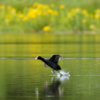EPISYRPHUS BALTEATUS, MARMALADE HOVERFLY, BZYG PRĄŻKOWANY
- Camera: NIKON D5200
- Flash fired: yes
- ISO: 1000
- Shutter speed: 1/200s
[insert_php] if(function_exists(‘spr_show_rating’)){echo spr_show_rating();} [/insert_php]
Episyrphus balteatus, called the marmalade hoverfly, is a relatively small hoverfly (9–12 mm), widespread throughout the Palaearctic region, which covers Europe, North Asia and North Africa. The upper side of the abdomen is patterned with orange and black bands. Two further identification characters are the presence of secondary black bands on the third and fourth dorsal plates and faint greyish longitudinal stripes on the thorax. Its color patterns may appear wasp-like to other animals, such as birds, protecting it from predation.
Episyrphus balteatus can be found throughout the year in various habitats, including urban gardens, visiting flowers for polen and nctar. They often form dense migratory swarms, which may cause panic among people for their resemblance to wasps. It is among the very few species of flies capable of crushing pollen grains and feeding on them.
As in most other hoverflies, males can be easily identified by their holoptic eyes, left and right compound eyes touching at the top of their heads
Source: Wikipedia
The photo is in JPG and uncompressed TIFF files. For printing, I reccommend the TIFF file.
I would be grateful if you could provide me with the information about how you used my work. If possible, send me pictures of that use.
You can download all photos for free as long as you provide appropriate credit.
They are licensed under the Creative Commons License.
You can read about the details on the Creative Commons official website.
This work is licensed under a Creative Commons Attribution 4.0 International License.





Leave a Reply
Want to join the discussion?Feel free to contribute!